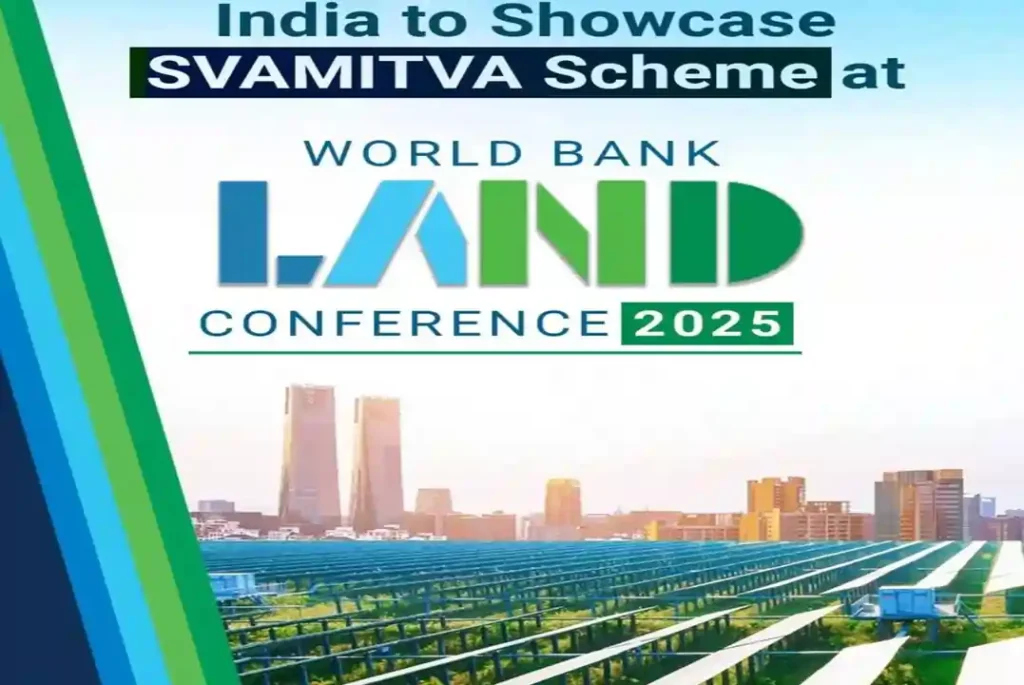New Delhi: At the prestigious World Bank Land Conference 2025, held in Washington D.C., India emerged as a global leader in inclusive land governance, spotlighting its transformative initiatives, the SVAMITVA Scheme and Gram Manchitra platform. As a designated Country Champion, India captivated global audiences with its technology-driven, community-centric approach to rural land management, setting a benchmark for sustainable development and economic empowerment.

India’s Role as Country Champion
On May 6, 2025, India took center stage during the High-Level Plenary Session titled “Good Practices and Challenges in Land Tenure and Governance Reform.” Shri Vivek Bharadwaj, Secretary of the Ministry of Panchayati Raj, delivered a compelling address, articulating India’s leadership in land rights, tenure reforms, and innovative spatial planning. Under the visionary leadership of Prime Minister Shri Narendra Modi, India has pioneered scalable models for rural governance, earning accolades for its inclusive and technology-driven strategies. The plenary session provided a platform for India to share its journey of overcoming systemic challenges through strategic cooperation, legal reforms, and advanced technological infrastructure.
SVAMITVA Scheme: A Game-Changer in Rural Land Governance
The SVAMITVA (Survey of Villages and Mapping with Improvised Technology in Village Areas) Scheme has redefined rural land governance in India. Shri Bharadwaj highlighted the scheme’s monumental achievements, noting that it has surveyed 68,000 square kilometers of rural land, unlocking an astounding $1.16 trillion worth of assets. By employing drone-based mapping and establishing Continuously Operating Reference Stations (CORS), SVAMITVA ensures precise demarcation of land parcels, granting millions of rural families legal property titles. This initiative addresses the long-standing issue of informal land holdings, a concept famously discussed by Peruvian economist Hernando de Soto, who emphasized the untapped economic potential locked in such assets.
The SVAMITVA Scheme’s impact transcends mere documentation. It fosters economic empowerment by providing rural landowners with legal recognition, enabling access to credit, and promoting entrepreneurship. For instance, Shri Bharadwaj shared inspiring anecdotes, such as a dairy farmer in Madhya Pradesh who expanded his business using his newly acquired property title as collateral, and a mother in Rajasthan who funded her daughter’s overseas education through land-backed financing. These stories underscore how SVAMITVA transforms land ownership into tangible opportunities, offering dignity and financial security to rural communities.
Key Benefits of SVAMITVA
- Economic Growth and Jobs: Streamlined access to property titles facilitates entrepreneurship, business expansion, wealth reinvestment, and alternative livelihoods, driving rural economic growth.
- Private Capital Mobilization: Registered property rights enable landowners to use their assets as collateral, boosting access to private credit and investment opportunities.
- Infrastructure Funding: By formalizing land ownership, SVAMITVA enhances government revenue through land and property taxes, which currently contribute only 0.6% of GDP in low-income countries compared to 2.2% in industrialized nations.
- Urban Management: Clear land titles aid cities in planning growth, protecting public spaces, identifying development opportunities, and mitigating disaster risks.
- Food Security: Improved access to land, especially for women, can increase agricultural outputs by up to 4%, contributing to food security and sustainable development.
Gram Manchitra: Empowering Grassroots Governance
On May 8, 2025, the spotlight shifted to Gram Manchitra, India’s advanced GIS-based spatial planning platform, presented by Shri Alok Prem Nagar, Joint Secretary of the Ministry of Panchayati Raj. Gram Manchitra empowers Gram Panchayats to create data-driven, localized development plans, integrating cutting-edge technology with grassroots governance. The platform’s applications in climate resilience, infrastructure planning, and scheme convergence were lauded for their applicability in the global south, where similar challenges in rural development persist.
Gram Manchitra facilitates spatially informed decision-making, enabling villages to plan for sustainable growth, disaster preparedness, and resource allocation. By leveraging geospatial data, it fosters resilient, self-reliant communities, aligning with global sustainable development goals (SDGs), particularly SDG Target 1.4.2, which emphasizes legal ownership and control over land for vulnerable populations.
Special Event: Securing Land Rights for a Billion People
A highlight of the conference was the Special Event on May 7, 2025, titled “Securing Land Rights for a Billion People.” Led by the Ministry of Panchayati Raj, the session opened with remarks by Dr. Klaus W. Deininger, Lead Economist at the World Bank, and Mr. Somik V. Lall, Senior Advisor, DECVP, World Bank. Shri Vivek Bharadwaj presented the design, impact, and scalability of the SVAMITVA Scheme, followed by an interactive Q&A session that reflected global interest in India’s approach.
The event attracted delegates from Africa, Latin America and the Caribbean, Central Asia, South Asia, and South East Asia, including Advisors and Senior Advisors to seven Executive Directors of the World Bank. This diverse audience provided a platform for cross-regional dialogue, fostering collaboration and knowledge exchange. The session explored how countries with similar land administration systems could adapt India’s model, with the Ministry of Panchayati Raj expressing readiness to support global partnerships in implementing technology-driven land governance solutions.
India’s Federal Approach to Land Reforms
Shri Bharadwaj emphasized the complexities of implementing land reforms within India’s federal structure. The SVAMITVA Scheme required onboarding states, amending state laws, and updating survey rules to align with national objectives. Community involvement was pivotal, ensuring that reforms were inclusive and participatory. The establishment of CORS infrastructure further enhanced the accuracy of drone-based mapping, setting a gold standard for scalable land governance initiatives.
Global Relevance and SDG Alignment
India’s interventions at the World Bank Land Conference 2025 positioned it as a thought leader in land tenure reforms and rural development. The SVAMITVA Scheme and Gram Manchitra serve as replicable models for nations striving to achieve SDG Target 1.4.2, which seeks to ensure legal ownership and control over land, particularly for vulnerable communities. By addressing centuries-old land insecurity, India’s initiatives pave the way for legal recognition, dignity, and prosperity for rural citizens worldwide.
The conference highlighted the global south’s shared challenges, such as informal land holdings, limited access to credit, and inadequate infrastructure funding. India’s success in monetizing $1.16 trillion worth of rural assets demonstrates the economic potential of formalized land rights, offering a blueprint for other nations to unlock similar opportunities.
Conclusion
India’s participation as a Country Champion at the World Bank Land Conference 2025 underscored its commitment to inclusive, technology-driven land governance. The SVAMITVA Scheme and Gram Manchitra platform exemplify how data-driven, participatory approaches can transform rural economies, empower communities, and align with global development goals. By sharing its successes and challenges, India invites other nations to adopt similar models, fostering collaboration and innovation in land tenure reforms. As the world grapples with land insecurity and economic disparities, India’s leadership offers a beacon of hope, demonstrating that technology and community engagement can unlock a new era of prosperity and dignity for rural populations.
Key Takeaways
- SVAMITVA Scheme: Surveyed 68,000 sq. km, monetized $1.16 trillion in rural assets, and empowered millions with legal property titles.
- Gram Manchitra: A GIS-based platform driving climate resilience, infrastructure planning, and localized development.
- Global Impact: India’s models offer scalable solutions for the global south, aligning with SDG Target 1.4.2.
- World Bank Land Conference 2025: A platform for cross-regional dialogue, showcasing India’s leadership in land governance.
FAQs
1. What is the SVAMITVA Scheme, and how was it highlighted at the World Bank Land Conference 2025?
The SVAMITVA (Survey of Villages and Mapping with Improvised Technology in Village Areas) Scheme is India’s flagship initiative to establish clear property ownership in rural areas by mapping land parcels using drone technology. At the World Bank Land Conference 2025 in Washington D.C., India showcased SVAMITVA as a transformative model for inclusive land governance. Shri Vivek Bharadwaj, Secretary of the Ministry of Panchayati Raj, presented its achievements, including surveying 68,000 square kilometers and monetizing $1.16 trillion in rural assets. The scheme’s ability to provide legal titles, enable access to credit, and empower rural communities was highlighted during the plenary session on May 6 and the special event “Securing Land Rights for a Billion People” on May 7, 2025.
2. How does the Gram Manchitra platform contribute to rural development, and why was it significant at the conference?
Gram Manchitra is a GIS-based geospatial planning platform that empowers Gram Panchayats to create data-driven, localized development plans. It supports climate resilience, infrastructure planning, and scheme convergence, fostering sustainable and self-reliant villages. At the World Bank Land Conference 2025, Shri Alok Prem Nagar, Joint Secretary of the Ministry of Panchayati Raj, presented Gram Manchitra on May 8, emphasizing its role in spatially informed decision-making. Its applicability for the global south was appreciated, as it addresses common challenges like disaster preparedness and resource allocation, aligning with global sustainable development goals.
3. What role did India play as a Country Champion at the World Bank Land Conference 2025?
As a Country Champion, India took center stage at the World Bank Land Conference 2025, demonstrating its leadership in land tenure reforms and rural governance. During the High-Level Plenary on “Good Practices and Challenges in Land Tenure and Governance Reform” on May 6, Shri Vivek Bharadwaj articulated India’s strategic approach, including legal reforms, technological infrastructure like Continuously Operating Reference Stations (CORS), and community involvement. India’s sessions, including the special event on May 7 and the Gram Manchitra presentation on May 8, positioned it as a global thought leader, fostering cross-regional dialogue with delegates from Africa, Latin America, Central Asia, and South East Asia.
4. How does the SVAMITVA Scheme support economic growth and align with global development goals?
The SVAMITVA Scheme drives economic growth by providing rural landowners with legal property titles, enabling entrepreneurship, access to private credit, and wealth reinvestment. It has unlocked $1.16 trillion in assets, supporting infrastructure funding through increased land and property tax revenue, which is currently only 0.6% of GDP in low-income countries compared to 2.2% in industrialized nations. By improving women’s access to land, it boosts agricultural output by up to 4%, enhancing food security. At the conference, India aligned SVAMITVA with SDG Target 1.4.2, which aims to ensure legal ownership and control over land for vulnerable communities, offering a scalable model for global adoption.
5. What was the significance of the special event “Securing Land Rights for a Billion People” at the conference?
The special event on May 7, 2025, titled “Securing Land Rights for a Billion People,” was a key highlight of the World Bank Land Conference 2025. Led by the Ministry of Panchayati Raj, it featured opening remarks by Dr. Klaus W. Deininger and Mr. Somik V. Lall from the World Bank, followed by a presentation by Shri Vivek Bharadwaj on the SVAMITVA Scheme’s design, impact, and scalability. The interactive Q&A session engaged delegates from diverse regions, facilitating discussions on adapting India’s model to other countries with similar land administration systems. The event underscored India’s readiness to collaborate globally, amplifying its transformative approach to inclusive land governance.

